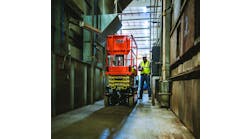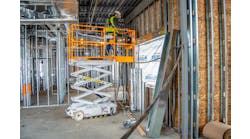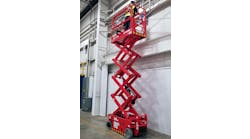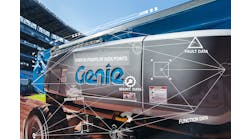Andrew Studdert, chairman and CEO of NES Rentals, last week talked with RER’s Michael Roth about the rays of hope he sees on the horizon for 2010, the company’s Yellow Ribbon campaign, the unexpected improvement he has seen in pricing disciplines, why we’ve all earned new t-shirts, and more.
RER: How is business and what do you expect business to be like in 2010?
Studdert: We’ve been very aggressive in the last 18 months in downsizing both our company and our fleet. We came to grips with this in late second quarter last year and moved aggressively, starting with the assumption that we would be off 20 percent, and that was in September 2008. By December we realized it was probably going to be closer to 30, and we adjusted the company down to that level.
By all indications we should see an improvement starting in, let’s just say the beginning of second half. We’re seeing pricing stabilization which is encouraging. Some of the disciplines that our competitors are starting to put in place we think are helping. Also a lot of the small companies that were in dire straits are either gone or had their equipment taken back. So we’re seeing more discipline out there in the marketplace.
Do you see any reason to expect an increase in late 2010?
We take a lot of different data points, we have a proprietary data source that we have been using for the past 18 months that looks at the aerial rental business through some very sophisticated modeling, and we believe we’re in the bottom of the cycle right now. They called it within 30 days of when the government announced it, so we have a high degree of confidence that business should start to pick up. We expect business to continue working at the bottom through the first half of next year, and then start to climb gradually. I don’t think it’s going to be a robust out-climb but we think with the combining of people eliminating fleet and the pricing disciplines plus demand, we’ll get both a utilization and pricing uptick starting in the latter half of the year.
What are your customers telling you and what are they expecting?
Customers are starting to get some business because of inventories being depleted so dramatically. We’re about evenly split 50-50 industrial and non-residential construction, so the industrial guys are starting to see a pick-up off the bottom because there has got to be a minimum level of stock so we’re starting to see that come back. We’re very targeted on nonresidential construction, and we’re getting significant business in all sectors from new manufacturing, surprisingly. We’re getting business from the chip side, hospitals and boats, and shipbuilding, a broad spectrum.
Are people starting to see a reason to invest?
They are unshuttering their plants and dusting off the old shovel-ready projects, so to speak.
Do you think the ARRA “stimulus” money will start to shake loose more?
I would be hopeful but not dependent on it.
How do you see the overall economy in 2010 in your various market areas?
We pulled back our footprint, so we’re now east of the Mississippi and in Texas, that’s our market. The Gulf Coast, the Northeast and the Midwest. I would say with the exception of the Midwest we think we’re going to have a pretty robust climb out, we think the Midwest is going to lag by six to nine months.
You’ve downsized the company and your fleet. Are you employing other strategies that are helping you?
In the past five years we’ve implemented a very rigorous safety-based culture, and one of the outcrops of that is we are completely compliant with all annual inspection requirements, and service bulletins for all of our manufacturers. We launched a program on Veterans Day in November, we’re going out to all of our customers, and we’re saying to them there’s a renewed focus by OSHA and by insurance companies in general to ensure that your worksite is compliant. We’re doing unannounced walk-arounds with our customers and going on to our equipment and doing a check to make sure the annual inspection is current.
If we determine a machine is current — and they have been all so far — we put an 8- to 10-inch yellow ribbon on each one of our pieces of equipment, and we’ve told our customers if we find a piece of equipment that isn’t compliant with annual inspection, that we’ll donate $500 in their name to the Wounded Warrior Fund.
We’ve established that we’ll give a minimum of $10,000 regardless of what we find. We’re doing it to make sure each customer has a safe work environment, we’re doing it to make sure that our records are current, but also it’s a way to differentiate ourselves. Because as people struggle in the financial downturn, my experience in a whole bunch of industries start to skimp on things and it calls to attention that other equipment on the site might not be as well maintained.
We’re only looking at our own equipment, but if they want us to walk around and see if somebody else’s equipment is up to date, we’ll see if there’s a sticker on it. Most companies don’t put stickers on their equipment that shows the annual inspection is good but we do. I think it’s important that the industry takes this seriously. If somebody is not maintaining their fleet, I think it’s an issue. We’re investing in the safe and reliable condition of our equipment and we think our customers should be aware of that.
Is this the toughest period you’ve been through?
It’s been the toughest year I’ve been through since joining this industry and also overall from a business standpoint. I don’t think any of us could have predicted it. I think the decisions we’ve all had to make are things we never felt we’d have to do.
We should all have t-shirts that say “We survived 2009!”





